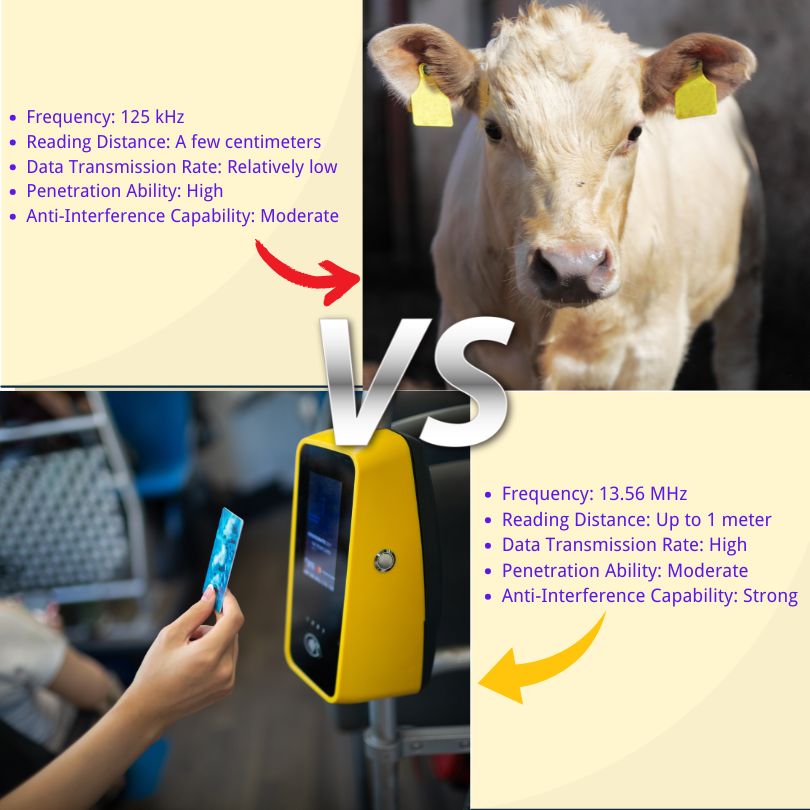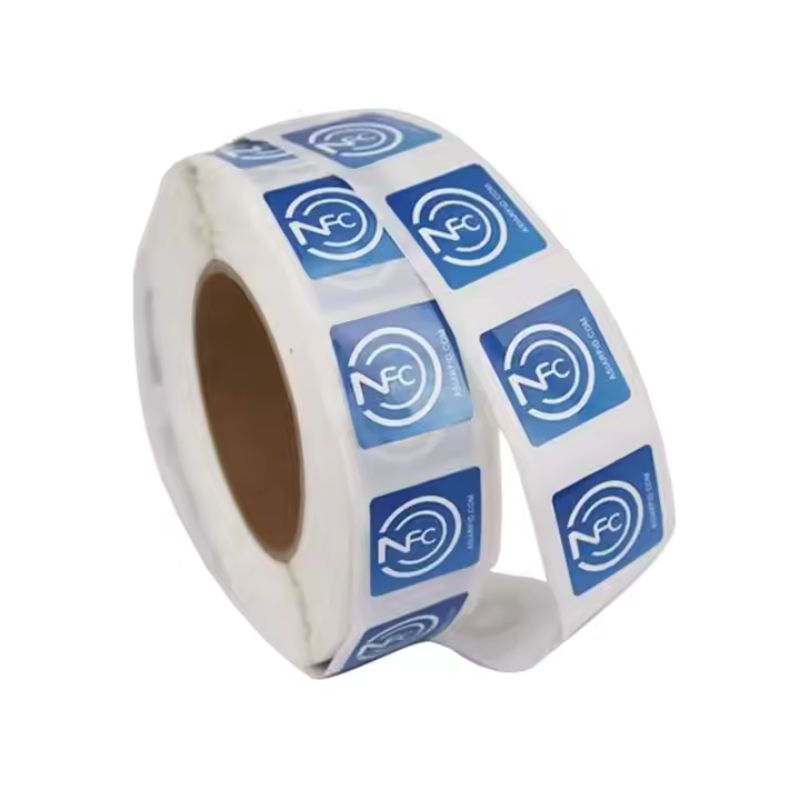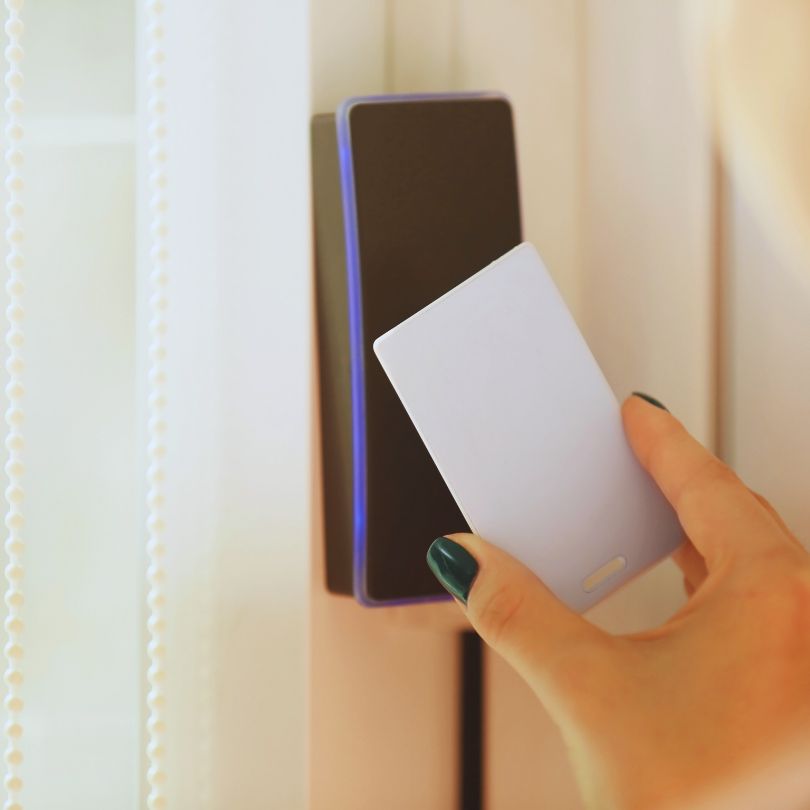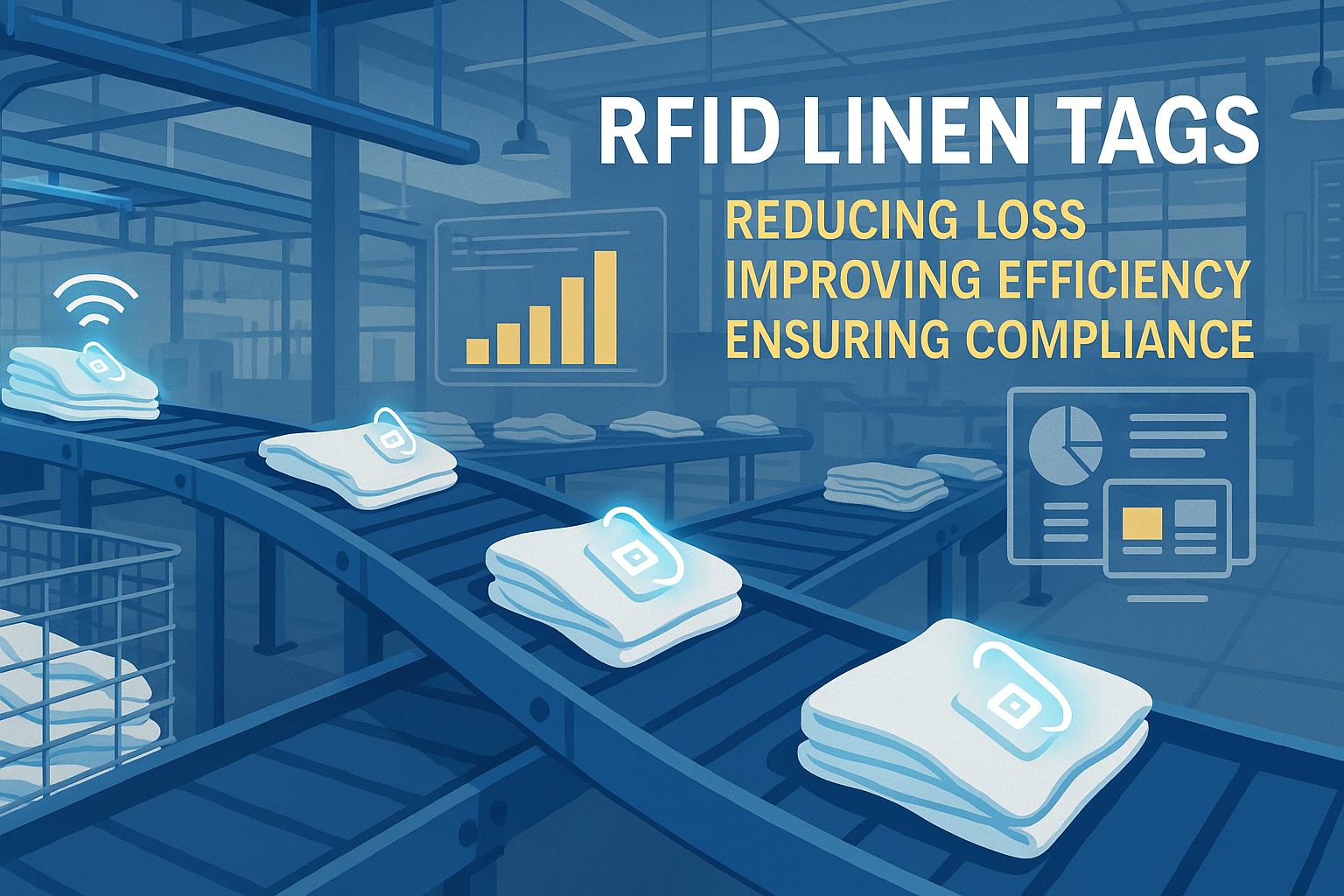
Razumijevanje razlika između 13,56 MHz i 125 kHz RFID oznaka
Sadržaj
Razumijevanje razlika između 13,56 MHz i 125 kHz RFID oznaka

Što RFID frekvencija doista znači (LF vs HF)
RFID sustavi koriste radio valove za komunikaciju između oznake i čitatelji. Frekvencija koju koriste utječe na to koliko daleko mogu čitati, koliko brzo šalju podatke, kako se ponašaju u blizini metala ili vode i kakve podatke mogu pohraniti.
Evo osnovne ideje:
RFID oznake niske frekvencije (LF) = 125 kHz
- Kratki domet
- Usporena brzina prijenosa podataka
- Izvrsne performanse u blizini metala ili tekućina
- Jednostavno, robusno i pristupačno
Visokofrekventni (HF) = 13,56 MHz RFID oznake - Veći domet
- Brža brzina prijenosa podataka
- Naprednija sigurnost
- Kompatibilno s NFC-om i pametnim telefonima
13,56 MHz naspram 125 kHz
| Značajka | 13,56 MHz RFID oznake | 125 kHz RFID oznake |
|---|---|---|
| Frekvencija | 13,56 MHz (HF) | 125 kHz (LF) |
| Opseg čitanja | Do 1 metar | 2–10 cm |
| Brzina prijenosa podataka | visoko | Niska |
| Performanse u blizini metala | Umjereno | Jaka |
| Sigurnost | Podržava enkripciju i uzajamnu autentifikaciju | Osnovno, obično bez enkripcije |
| Podrška za NFC / pametne telefone | Da | Ne |
| trošak | viši | Donji |

Sigurnost: Je li jedna frekvencija sigurnija?
125 kHz RFID oznake Često se koriste u starijim sustavima i obično koriste fiksne jedinstvene ID-ove bez enkripcije. Zbog toga ih je lako klonirati pomoću gotovih uređaja. Prikladni su za sustave niskog rizika, ali ne zadovoljavaju suvremene sigurnosne standarde.
13,56 MHz RFID oznake, posebno MIFARE ili DESFire kartice, podržavaju:
- Šifriranje
- Uzajamna autentifikacija
- Sigurno pohranjivanje memorije
- Više aplikacija na jednoj kartici
Suština: - Koristite RFID oznake od 125 kHz za potrebe niske sigurnosti (kao što su ključevi za ormariće, satovi za evidentiranje radnog vremena).
- Odaberite 13,56 MHz za kontrolu pristupa, plaćanja ili bilo koji sustav koji pohranjuje osobne podatke.
NFC i kompatibilnost sa pametnim telefonima
Ako vaš projekt uključuje telefone, RFID oznake od 125 kHz neće raditi.
Samo 13,56 MHz RFID oznake podrška za NFC (Near Field Communication) – tehnologiju koja se koristi za mobilna plaćanja, prijave i značajke povezivanja dodirom.
Većina pametnih telefona može čitati i pisati NFC oznake na 13,56 MHz, što ovu frekvenciju čini idealnom za:
- Digitalne ulaznice
- Prijave na događaj
- Pametni plakati
- Kartice vjernosti
- Beskontaktni mobilni ID
Ako je podrška pametnim telefonima važna, 13,56 MHz je vaš jedini izbor.
Praktični primjeri upotrebe po industrijama
| Industrija / Primjena | 125 kHz RFID oznake | 13,56 MHz RFID oznake |
|---|---|---|
| Kontrola pristupa | Osnovni ulazni sustavi, naslijeđena vrata | Zaštićene vjerodajnice, moderne iskaznice |
| Javni prijevoz / Prodaja karata | Nije podržano | Karte za prijevoz temeljene na MIFARE/NFC tehnologiji |
| Praćenje životinja | Široko se koristi zbog prodiranja u tkivo | Rijetko |
| Industrijska automatizacija | Pouzdano pri radu s metalom/tekućinom, za zahtjevnu upotrebu | Rjeđe u surovim okruženjima |
| zdravstvo | Nije idealno za praćenje pacijenata ili lijekova | Bolje za sigurno identificiranje i označavanje imovine |
| Knjižnice / Arhivi | Rijetko | Popularno za praćenje knjiga i posudbe |
| Marketing / Događaji | Ne primjenjivo | Pametni plakati, NFC ulaznice za događaje |
| Protuprovalna zaštita za vozilo | Ugrađene RFID oznake od 125 kHz u ključevima/paljenju | Nije korišteno |

Kako odabrati između 13,56 MHz i 125 kHz za vaš projekt
Koristite ovaj kontrolni popis kako biste suzili svoj izbor:
1. Razina sigurnosti
- Trebate li enkripciju ili siguran pristup? → Odaberite 13,56 MHz
- Prati s niskim rizikom ili osnovna identifikacija? → 125 kHz može biti dovoljno.
2. Okoliš
- Jaka interferencija, metal ili tekućina u blizini? → 125 kHz radi bolje
- Čist ured ili zatvoreni prostor? → Oboje je u redu; odaberite prema značajkama.
3. Integracija pametnog telefona
- Želite li da korisnici skeniraju telefonom? → Samo 13,56 MHz to podržava
4. Proračun
- 125 kHz oznake su jeftinije na početku
- Ali 13,56 MHz nudi veću dugoročnu vrijednost ako trebate značajke ili sigurnost.
Još uvijek koristite RFID oznake od 125 kHz? Nadogradnja ili ostanak?
RFID oznake od 125 kHz i dalje se široko koriste u:
- Naslijeđeni sustavi kontrole pristupa
- Proizvodne operacije
- Označavanje stoke
- Automobilski protukrađeni sustavi
Ali ako upravljate: - Akreditacije osoblja
- Sustavi plaćanja
- Višenamjenske iskaznice
- NFC integracija
…onda bi možda bilo vrijeme za promjenu.
Putovi nadogradnje:
- Instalirajte čitače dvostruke frekvencije
- Izdajte kombinirane kartice (podržavaju i 13,56 MHz i 125 kHz)
- Postupno uvođenje: podržati oba sustava tijekom migracije
Često postavljana pitanja o RFID-u 13,56 MHz naspram 125 kHz
Je li 13,56 MHz isto što i NFC?
Da, NFC je vrsta RFID-a od 13,56 MHz. Većina pametnih telefona ga podržava.
Može li jedan čitatelj čitati obje frekvencije?
Obično ne. Trebat će vam čitač s dvostrukom tehnologijom da bi podržao oboje.
Koja oznaka ima veći domet?
13,56 MHz općenito ima dulji domet čitanja (do 1 metra). 125 kHz je ograničen na nekoliko centimetara.
Koje da koristim za kontrolu pristupa?
Za moderne, sigurne sustave pristupa snažno se preporučuje 13,56 MHz.
Zašto RFID oznake od 13,56 MHz i 125 kHz imaju različite udaljenosti čitanja?
Razlika u udaljenostima čitanja prvenstveno je posljedica radne frekvencije. Više frekvencije poput 13,56 MHz imaju veći domet, dok su niže frekvencije poput 125 kHz optimizirane za kraće udaljenosti.
Koja je RFID oznaka prikladnija za metalna ili tekuća okruženja?
RFID oznake od 125 kHz učinkovitije su u okruženjima s metalima ili tekućinama zbog svojih superiornih sposobnosti prodiranja.
Utječe li cijena RFID oznaka na izbor?
Da, RFID oznake od 125 kHz općenito su isplativije, što ih čini prikladnom opcijom za aplikacije koje štede proračun. Međutim, izbor također treba uzeti u obzir zahtjeve za performansama i okruženja aplikacije.
Ključni standardi i vrste čipova
13,56 MHz (HF)
- ISO/IEC 14443: Koristi se u beskontaktnim karticama (MIFARE, DESFire)
- ISO/IEC 15693: veći domet, koristi se u knjižnicama, logistici
- ISO 18000-3: praćenje na razini predmeta
125 kHz (LF)
- Zaštićeni formati, često s fiksnim ID-om (npr. EM4100, HID Prox)
- Uglavnom se koristi u starijim sustavima i osnovnim aplikacijama.
Završne poruke
Ako se još uvijek pitate kojim putem krenuti, evo sažetka:
Koristite RFID oznake od 125 kHz za:
- Surovi uvjeti (metal/tekućina)
- Aplikacije niske sigurnosti
- Uvođenja s obzirom na proračun
- Naslijeđeni sustavi
Koristite RFID oznake od 13,56 MHz za:
- Podrška za mobilne uređaje/NFC
- Siguran pristup i plaćanje
- Višenamjenske kartice
- Sustavi spremni za budućnost
Oba imaju svoje mjesto—ali trebali biste birati prema slučaju upotrebe, a ne samo prema cijeni ili navici.
Komentari
Vrući proizvodi

Što je upravljanje otpadom pomoću RFID-a
Zamislite grad u kojem svaki kanti za smeće govori — ne doslovno — nego putem malog čipa koji sustavu javlja kada je pun, kada je ispraznjen i kamo je odvezen. To je ono što RFID upravljanje otpadom danas radi.

Što su Bolt Seals i njihove primjene? | Potpuni vodič
U globalnoj trgovini i logistici, boltni pečati igraju ključnu ulogu u osiguravanju sigurnosti tereta i usklađenosti. Ovi mali, ali moćni uređaji dizajnirani su za zaključavanje transportnih kontejnera, prikolica i vrata tereta pomoću mehanizma koji otkriva neovlašteni pristup.

Što je zaštitnik RFID kartice? Prednosti, primjeri upotrebe i vodič za kupnju
RFID tehnologija (radiofrekvencijska identifikacija) prisutna je posvuda: u vašim kreditnim karticama, iskaznicama, prijevoznim karticama, ključevima hotelskih soba i još mnogo toga. Pruža brzinu i praktičnost, ali također otvara vrata novoj vrsti digitalne krađe nazvanoj “skimming”. Tu na scenu stupa zaštitnik RFID kartica.

RFID narukvice za događaje: Vodič za organizatore pri kupnji na veliko
RFID narukvice za događaje postaju omiljeno rješenje za organizatore kojima je potreban brži ulazak, sprječavanje prijevara i beskontaktno plaćanje na koncertima, festivalima i sportskim objektima. Za razliku od papirnatih ulaznica ili QR kodova, ove pametne narukvice koriste ugrađene čipove za pojednostavljenje pristupa, sigurnost transakcija i poboljšanje iskustva gostiju.

Kako RFID oznaka na vjetrobranskom staklu poboljšava kontrolu pristupa vozilu i sustave naplate cestarina
U današnjem brzom svijetu identifikacija vozila mora biti brza, sigurna i beskontaktna. RFID oznaka na vjetrobranskom staklu pruža upravo to — pouzdan način naplate cestarina, parkiranja i kontroliranog pristupa bez zaustavljanja vozila.

Prednosti RFID oznaka za rublje u komercijalnim praonicama
Upravljanje rubljem u bolnicama, hotelima ili velikim praonicama rublja veliki je posao. Svaki dan se tisuće plahti, ručnika i uniformi peru, sortiraju i vraćaju natrag. No problemi poput izgubljenog rublja, pogrešaka pri sortiranju i ručnog brojanja mogu tvrtkama koštati mnogo novca. Na primjer, hoteli srednje veličine mogu godišnje izgubiti više od $200.000 zbog nestalog rublja.
Tu na scenu stupa RFID oznaka za rublje.
oznake
POVEZANI BLOGOVI

Što je upravljanje otpadom pomoću RFID-a
Zamislite grad u kojem svaki kanti za smeće govori — ne doslovno — nego putem malog čipa koji sustavu javlja kada je pun, kada je ispraznjen i kamo je odvezen. To je ono što RFID upravljanje otpadom danas radi.

Što su Bolt Seals i njihove primjene? | Potpuni vodič
U globalnoj trgovini i logistici, boltni pečati igraju ključnu ulogu u osiguravanju sigurnosti tereta i usklađenosti. Ovi mali, ali moćni uređaji dizajnirani su za zaključavanje transportnih kontejnera, prikolica i vrata tereta pomoću mehanizma koji otkriva neovlašteni pristup.

Što je zaštitnik RFID kartice? Prednosti, primjeri upotrebe i vodič za kupnju
RFID tehnologija (radiofrekvencijska identifikacija) prisutna je posvuda: u vašim kreditnim karticama, iskaznicama, prijevoznim karticama, ključevima hotelskih soba i još mnogo toga. Pruža brzinu i praktičnost, ali također otvara vrata novoj vrsti digitalne krađe nazvanoj “skimming”. Tu na scenu stupa zaštitnik RFID kartica.




